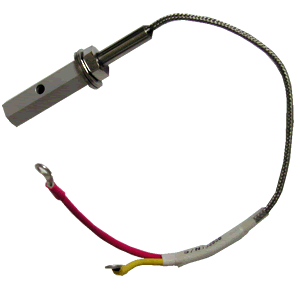 Data from the OAT probe on aircraft can be used in several calculation such as flight planning, aircraft take-off performance, cruise performance, density altitude and so forth. Data from the OAT probe on aircraft can be used in several calculation such as flight planning, aircraft take-off performance, cruise performance, density altitude and so forth.
In modern day aircraft, external air temp obtained via the Outside Air Temperature (OAT) probe, for the basic input for air data computers. There are two things to be kept in mind; one, the Static Air Temperature, or SAT, i.e. the temperature of the undisturbed air through which the aircraft will fly and second, the air temperature as the aircraft flies through it. This latter temperature is always a bit higher than the former (dur to kinetic energy is converted to heat at the sensor).
Although the OAT probe in aircraft is important, most pilots / owners of aircraft tend to ignore it. OAT data is used for recognizing potential icing conditions and in determining such essential parameters as density altitude and true airspeed. Ideally, the OAT probe should be part of the Advanced Flight Systems EFIS package or at least part of any other glass cockpit package, or as a stand-alone gauge in a traditional cockpit.
IDEAL OAT PROBE LOCATION:
To begin with, the OAT probe should be mounted externally of the aircraft – not in the cabin air scoops, not inside the fuselage and definitely not inside the cowling. You won’t get accurate Outside Air Temperature reading this way.
Generally speaking, the probe should be placed away from any sources of heat, and out of direct sun light. A location under the wing, sufficiently outboard to avoid exhaust heat, or on the bottom of the fuselage would be ideal.
For single engine installation, avoid mounting the OAT Probe on the side of the Aircraft Sensors. Additionally, for the OAT to function accurately, a sun shield must also be installed.
Most OAT have two wires (moulded or unmoulded). One wire would be red – this is the power supply wire. The other wire carries the Oil Temp Probes data from the Outside Air Temperature (OAT) probe to the instrument receiving the information.
Remember that the temperature indicated by the OAT probe is the Ram Air Temperature (RAT) so called because the oncoming air as it is brought to rest and compresses at the front of the probe. For those technically included, you can arrive at the actual OAT by using the formulae TAT = SAT + (K × TAS² / 7592)
Where: TAT is the output from the probe. SAT is figure to be derived (in Celsius). K is the recovery factor of the probe (usually 0.8 to 0.9). TAS is True Airspeed (TAS) is in knots.
For more information purchase, please visit: https://www.jpinstruments.com/shop/oat-probe/
|